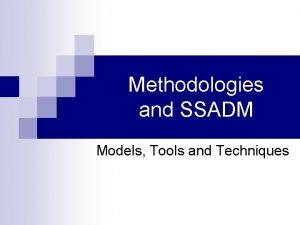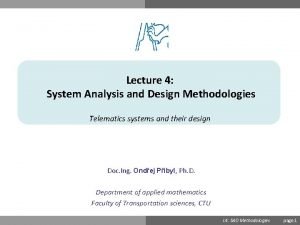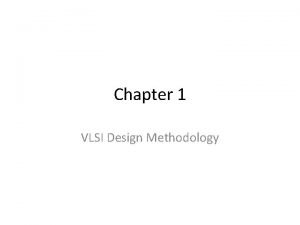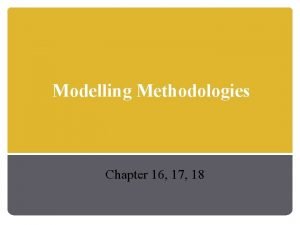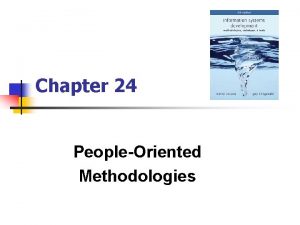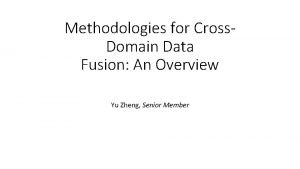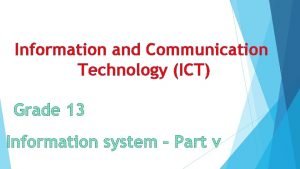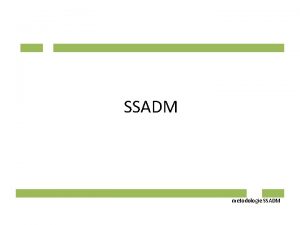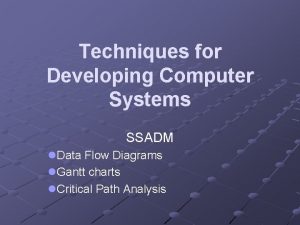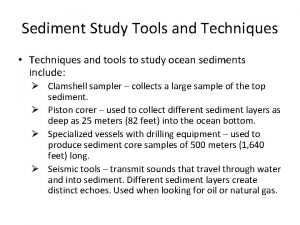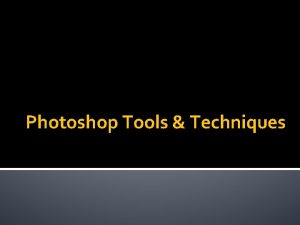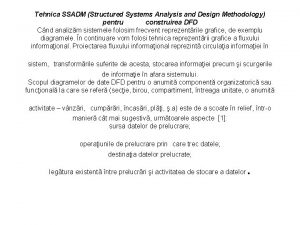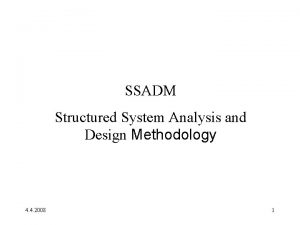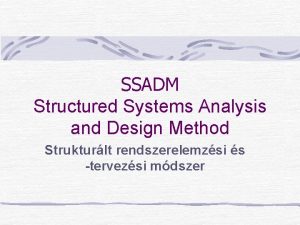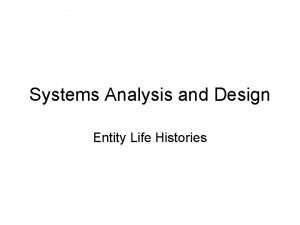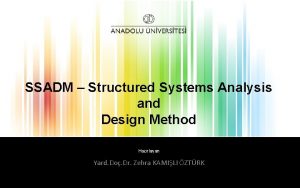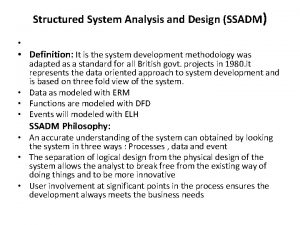Methodologies and SSADM Models Tools and Techniques Methodologies













- Slides: 13

Methodologies and SSADM Models, Tools and Techniques

Methodologies n A methodology… ¨ provides guidelines to follow for completing every activity of the systems development life cycle ¨ Why follow a methodology? clarity of records n consistency of approach n standardisation of recording but flexibility within rules n

Methodologies - examples n Structured Approach… ¨ SSADM n Object Orientated Approach ¨ Object Orientated Analysis and Design Methodology n Views a system as a collection of interacting objects

Methodologies – more examples n RAD – ¨ Rapid Application Development n a system development strategy that emphasizes speed of development through extensive user involvement

SSADM – What is it? n SSADM ¨ Structured Systems Analysis and Design Methodology n Purpose… ¨ formalize the requirements process ¨ introduce best practice techniques

Why use SSADM? n Open Industry Standard n Developed by the UK government in 1982; mandatory use for some Civil Service applications; now mature and widely used n Use supported by many CASE tools (e. g. Select) n Builds on the traditional Systems Development Life Cycle and has clearly defined stages n Disciplined approach will improve the quality of systems

SSADM Structure Feasibility study Requirement Analysis Requirement Specification Logical System Specification Physical Design

Feasibility Study n One stage module n Stage 0 >> n analysis of a business area to determine whether a system can cost effectively support the business requirements Feasibility Report Produced

Requirements Analysis n Two stage module n Stage 1 >> Investigation ¨ investigating the current environment ¨ identifying problems or areas that need improvement n Stage 2 >> Business System Options ¨ develops a range of options that meet the defined requirements ¨ select one option as the basis for the desired system

Requirements Specification n One stage module n Stage 3 >> ¨ Having selected a specific ‘Business System Option’ a detailed specification of requirements now begins. ¨ emphasis is on determining the desired system data, functions and events ¨ Prototyping techniques are also suggests for the development of the HCI ¨ DFD’s and ERD’s are developed

Logical System Specification n Two stage module n Stage 4 >> Technical System Options ¨ This assesses the different options for implementing the specification ¨ describes the costs, benefits and constraints n Stage 5 >> Logical Design ¨ Design of program logic… n What the programs have to do

Physical Design n One stage module n Stage 6 >> ¨ The Physical Environment the system will operate in is considered Physical database design n Performance n Processing characteristics n Physical screen designs are developed n

Conclusion n Methodologies… Helps analysts and businesses develop a better understanding of the system requirements.
 Structured system analysis and design methodology
Structured system analysis and design methodology Ssadm tools
Ssadm tools System analysis and design methodologies
System analysis and design methodologies Difference between models and semi modals
Difference between models and semi modals Types of quantitative research designs
Types of quantitative research designs Vlsi basics
Vlsi basics Wikipedia agile project management
Wikipedia agile project management Define the relationship chapter 16
Define the relationship chapter 16 People oriented methodologies
People oriented methodologies Domain testing in software testing
Domain testing in software testing Indigenous methodologies
Indigenous methodologies Business performance management methodologies
Business performance management methodologies Methodologies for cross-domain data fusion: an overview
Methodologies for cross-domain data fusion: an overview Structured system of communication
Structured system of communication

